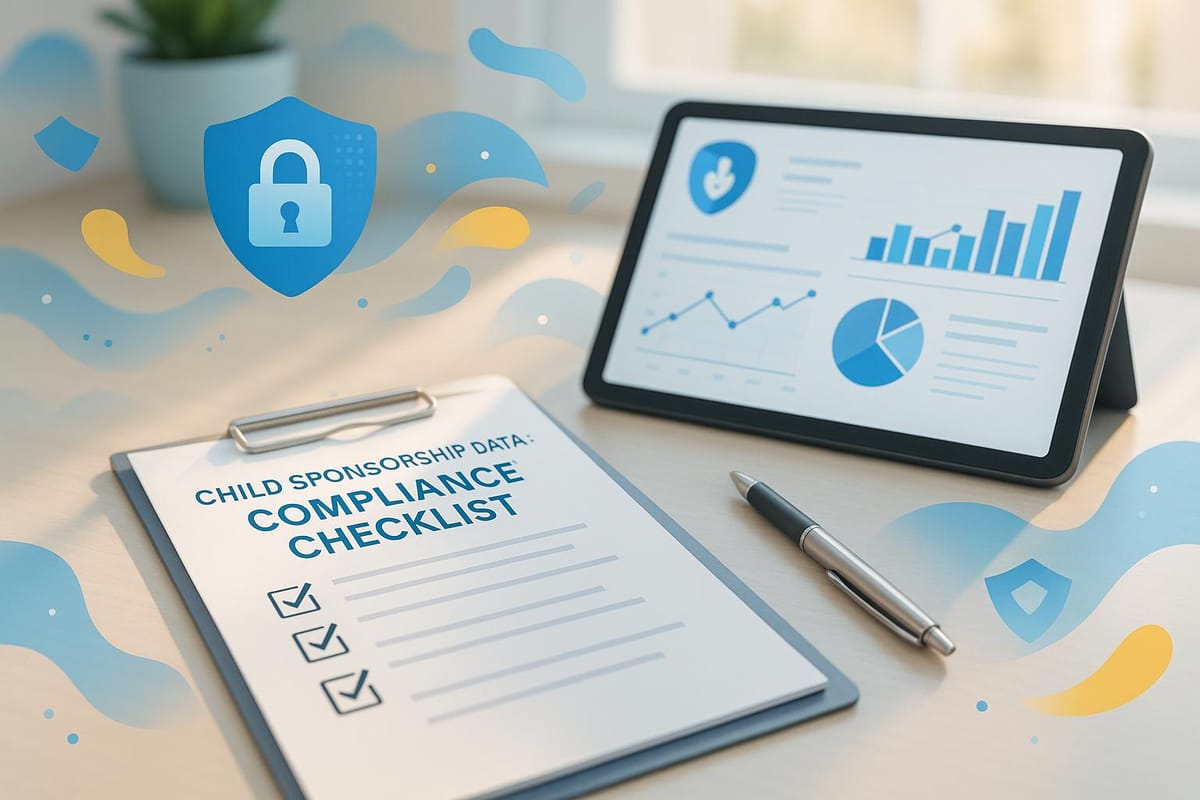Child Sponsorship Data: Compliance Checklist
Ensure compliance with child sponsorship data laws by following essential guidelines for privacy, consent, and security measures.

Managing data for child sponsorship programs is a high-stakes task. Nonprofits handle sensitive information about children and sponsors, making compliance with privacy laws critical. Here's what you need to know:
- Key Laws: Follow regulations like COPPA (parental consent for children under 13), CCPA (California privacy rights), and GDPR (EU data protection). Non-compliance can lead to fines up to $21.5 million or 4% of annual revenue.
- What Counts as Personal Data: Includes names, photos, health records, payment details, and even location data.
- Consent Requirements: Parental consent is mandatory for child data. Sponsors and donors must also give explicit permission for data use.
- Security Measures: Encrypt data, limit access, and use secure backups. Regular audits are essential.
- Staff Training: Educate employees on data handling and privacy laws. Clear protocols are necessary to avoid mistakes.
- Tech Tools: Platforms like HelpYouSponsor automate consent tracking, data management, and reporting.
Protecting data builds trust, ensures compliance, and supports your mission. Follow this checklist to safeguard sensitive information and maintain donor confidence.
Key Data Protection and Privacy Laws
Relevant Laws Overview
Child sponsorship programs must adhere to federal and state regulations designed to protect personal data. Among these, the Children's Online Privacy Protection Act (COPPA) is particularly crucial for nonprofits working with children under 13. COPPA requires parental consent and mandates clear privacy policies that explain how data is collected and used.
In addition to COPPA, nonprofits need to comply with laws like the CAN-SPAM Act and the Telephone Consumer Protection Act (TCPA) when sending emails or text messages. These laws ensure that communications are sent with proper consent and include straightforward opt-out options.
For organizations serving California residents, the California Consumer Privacy Act (CCPA) introduces additional requirements. This law grants residents rights over their personal data, such as the ability to know what data is collected, request its deletion, or opt out of its sale. Even nonprofits located outside California must comply if they collect data from California residents.
For nonprofits with an international presence, the General Data Protection Regulation (GDPR) applies when dealing with donors or sponsors in the European Union. GDPR enforces strict guidelines for collecting, processing, and storing personal data, with extra protections for children's information.
Violating these laws can lead to significant financial penalties. For example, the FTC has collected over $100 million in fines from companies that breached COPPA since its introduction. GDPR violations carry even steeper penalties, with fines reaching up to €20 million or 4% of a company’s global revenue, whichever is greater.
In a high-profile case, the FTC fined TikTok (then Musical.ly) $5.7 million in 2019 for violating COPPA by collecting data from children without parental consent. The company was also required to delete improperly collected data and implement new compliance measures.
Understanding these regulations provides a foundation for identifying what qualifies as personal data.
What Counts as Personal Data
Personal data includes obvious details like names and birth dates, but it also extends to less apparent information. For children in sponsorship programs, this might include photographs, school names, village details, or family background. For sponsors and donors, it covers contact information (emails, phone numbers, mailing addresses), payment details, and donation history. Even preferences or patterns in communication and donations are considered personal data under most regulations.
Biometric data is another area requiring special attention. This includes fingerprints, facial recognition data from photos, or any other unique physical traits that could identify someone. For instance, detailed photographs of children might fall under this category if facial recognition technology is used.
Location data also poses challenges. Whether it’s a specific village, regional information, or GPS coordinates, such details can create safety risks if mismanaged. Even general information like "rural Guatemala" or "northern Kenya" can become personal data when combined with other identifying factors.
The key takeaway is that personal data isn’t limited to direct identifiers. Any combination of details that could reasonably identify an individual qualifies. For example, a child's age, grade, and general location might seem harmless individually, but together they could pinpoint a specific child in a small community.
With this understanding, nonprofits can better categorize and manage data to comply with legal requirements.
Different Data Types Explained
Recognizing the differences in data types is critical for applying the proper compliance measures. Child data, sponsor data, and donor data each come with unique requirements.
Child data requires verified parental consent under COPPA. This means nonprofits must obtain clear, documented approval from a parent or guardian before collecting any information. An email notification alone isn’t enough; organizations need proof that a parent has reviewed and agreed to the data collection terms.
Sponsor data refers to information about individuals who financially support a child. While this data doesn’t require parental consent, it does demand informed consent from the sponsor. Nonprofits must also ensure secure storage, often using encryption, and respect sponsors' rights to access, correct, or delete their data.
Donor data involves general supporters who may not sponsor a specific child. This data requires transparent privacy policies, explicit consent before collection, and opt-out options for future communications. Compliance with laws like CAN-SPAM is essential here.
| Data Type | Primary Requirements | Consent Needed | Retention Period |
|---|---|---|---|
| Child Data (Under 13) | Verified parental consent, COPPA compliance, enhanced security | Parental consent | Only while sponsorship is active |
| Sponsor Data | Informed adult consent, secure storage, access rights | Individual consent | 3–7 years for financial records |
| Donor Data | Transparent policies, opt-out options, CAN-SPAM compliance | Individual consent | Varies by purpose and regulation |
The consent process and ongoing obligations differ based on the type of data. Child data requires ongoing parental involvement, as minors cannot legally consent. Sponsor and donor data, on the other hand, involve adults who can make their own privacy decisions, though nonprofits must still provide clear information about data use and respect individual rights.
Compliance Checklist Steps
Data Collection and Classification
Start by cataloging all personal data your organization collects. This includes straightforward details like names and addresses, but also extends to less obvious information such as photographs, family details, and communication preferences. Make sure to inventory where this data comes from, how it flows, and where it’s stored.
Document each data source systematically. For every type of data, record its origin and explain why it’s needed for your operations. This documentation is critical for demonstrating compliance.
Once collected, classify the data according to its sensitivity and any legal requirements. For example, child data protected under COPPA demands the highest level of security and verified parental consent. Financial information from sponsors and donors must meet strict standards for payment processing security. Even general contact details require proper consent and secure handling, though they may have less stringent storage needs.
If you use a CRM, integrate it to streamline data classification and ensure secure data migration.
Consent and Privacy Notices
With your data sources mapped, the next step is to communicate your practices transparently. Create privacy notices in plain language that explain what data is collected and how it will be used.
For child data collection, implement a rigorous parental consent system. COPPA requires more than an email notification. You’ll need documented proof that a parent or guardian has reviewed your privacy policy and explicitly agreed to data collection. This might involve methods like digital signatures, mailed consent forms, or recorded phone confirmations.
Design separate consent processes for different types of data. For instance, sponsors should be informed about how their financial data is secured and what communications they can expect. Donors should know how their contact information will be used and have an easy way to opt out of future communications.
As your programs evolve, update your privacy notices. If you introduce new methods of data collection or change how existing information is used, notify individuals and obtain fresh consent when necessary. Keep a record of when notices were updated and who received them.
Data Security Measures
Once you’ve classified the data and secured consent, it’s time to protect the information. Encrypt all personal data and implement role-based access controls. For example, sponsor payment details, child photographs, and donor contact information should all be encrypted following current industry standards. Not every staff member needs access to all data - set permissions so that field coordinators can access child-related information relevant to their region, while fundraising teams can view donor data without accessing sensitive child details. Regularly review and document who has access to what information.
Establish secure backup systems and test your data recovery processes on a regular basis. If you’re moving to the cloud, choose a reputable provider with strong security certifications and ensure proper setup to avoid vulnerabilities.
Keep detailed audit logs of data access. These logs can be critical during a regulatory investigation or in the event of a data breach. Many modern systems generate these logs automatically, simplifying compliance monitoring.
Staff Training and Accountability
Train everyone who handles personal data - whether they’re full-time employees, volunteers, or contractors - on privacy regulations and your organization’s specific policies. Focus on practical scenarios they’re likely to encounter, rather than just theoretical concepts.
Develop clear protocols for handling data access, deletion, and complaints. Written guidelines remove ambiguity and ensure consistent responses across the board.
Make privacy protection a shared responsibility. You can incorporate regular privacy assessments into employee reviews, require incident reporting, or even recognize staff who proactively identify potential compliance risks.
Establish a clear chain of command for privacy-related decisions. Assign specific individuals to approve data sharing with partners, handle regulatory inquiries, or authorize emergency data access. This prevents unauthorized actions that could lead to privacy violations.
Data Requests and Documentation
Set up efficient procedures to handle requests for access, correction, or deletion of personal data, ensuring you meet mandated deadlines.
Standardize forms and processes for different types of requests. For example, a sponsor updating their contact details will follow a different process than a parent requesting the deletion of their child’s data. Clear procedures help speed up response times and reduce the risk of missing legal requirements.
Keep detailed records of consent, training sessions, and any security incidents. Regulatory audits often require these documents, and having them well-organized demonstrates your commitment to compliance.
Clearly outline your data retention policies. Specify how long you’ll keep each type of information and the reasons behind it. For instance, child sponsorship data might only be retained while the sponsorship is active, while financial records may need to be kept for seven years to comply with accounting laws. These retention schedules not only help with compliance but also make storage management more efficient.
What Data Must Nonprofits Inventory For Compliance? - The Nonprofit Digest
Using Technology for Compliance
Managing compliance manually can quickly become unmanageable as programs grow. Nonprofit platforms like HelpYouSponsor simplify this process by automating key tasks and securely organizing all data in one place. Below, we’ll explore how technology helps with data management, consent tracking, and audit reporting.
Centralized Data Management
Scattered data storage increases the risk of errors and inefficiencies. A unified platform like HelpYouSponsor eliminates this issue by securely consolidating sponsor, child, and donation information into a single system. This approach not only streamlines data organization but also ensures consistent security measures are applied across your entire organization.
Automated Consent Tracking
Manually tracking consent can lead to mistakes, but automation removes that risk. HelpYouSponsor keeps a permanent, searchable record of consent, making it easy to confirm exactly when and how consent was obtained. This reliable documentation ensures your organization can meet regulatory requirements for data handling without added stress.
Built-in Reporting and Audit Tools
Compliance becomes much more manageable with built-in reporting tools. HelpYouSponsor offers features like 'Save Custom Views in the Donations' and seamless CRM integration, allowing you to create tailored reports and maintain detailed audit trails. These tools simplify generating compliance reports and tracking key data whenever needed, ensuring you’re always prepared for audits.
Ongoing Compliance Monitoring
Staying compliant isn’t a one-and-done task - laws shift, threats adapt, and keeping a close watch is essential to protect your child sponsorship program and maintain strong data protection practices. Continuous monitoring works hand-in-hand with earlier measures to ensure nothing slips through the cracks.
Regular Audits and Security Checks
Make it a habit to run internal audits regularly. These should map out how data flows through your system, check access controls, and assess storage practices. Any discrepancies you uncover should be documented and addressed right away to prevent potential issues.
Keeping Staff Knowledge Current
Your team plays a key role in compliance. Keep them informed about the latest data protection policies and regulatory updates. Track and document training sessions to show that your staff is well-prepared and up-to-date.
Third-Party Contract Reviews
Vendors and third-party providers are part of the equation too. Periodically review their contracts to ensure they meet data security standards and have clear breach notification protocols in place. Regularly confirm that these commitments are being upheld to maintain secure data practices across the board.
Key Takeaways
This section highlights the essential steps and ongoing efforts required to maintain data compliance. Protecting child sponsorship data is not just about following regulations - it’s about earning donor trust and safeguarding the individuals your programs serve. The compliance checklist provided offers a clear path to navigate data protection laws, implement security protocols, and maintain vigilance over time.
Data classification and consent management are the cornerstones of compliance. Understand the types of personal information you collect, secure explicit and documented consent, and keep thorough records. Regular staff training is crucial to ensure your team stays informed about changing regulations, while your security measures must evolve to address emerging threats.
Technology can make this process more efficient. Platforms like HelpYouSponsor, mentioned earlier, simplify compliance by centralizing data management, automating consent tracking, and offering built-in reporting tools. These features not only reduce manual effort but also ensure you’re well-prepared for audits and regulatory reviews.
To stay compliant, ongoing monitoring is key. This includes conducting regular audits, updating staff knowledge, and reviewing contracts with third-party vendors. As laws shift and your organization grows, these practices help keep your program secure and aligned with regulations.
Data compliance does more than mitigate risks - it strengthens your mission. When donors trust that their information is safe, they’re more likely to support your programs over the long term. This stability benefits the children in your sponsorship programs, ensuring they have access to transparent and accountable support.
FAQs
What happens if nonprofits don’t comply with data protection laws like COPPA, CCPA, or GDPR?
Nonprofits that don't adhere to data protection laws like COPPA, CCPA, or GDPR can face serious repercussions. These include steep fines, potential legal battles, and damage to their reputation - issues that can shake donor confidence and hinder fundraising efforts. For instance, GDPR violations can result in penalties as high as €20 million or 4% of an organization's annual global revenue, whichever is greater.
The consequences don’t stop at financial hits. Noncompliance could also lead to restrictions on data processing, which can severely disrupt the operation of sponsorship programs and other key activities. To steer clear of these challenges, nonprofits need to consistently review and update their data protection policies, ensuring they meet the latest regulatory standards.
What steps should nonprofits take to obtain and document parental consent for collecting child data under COPPA?
To meet the requirements of the Children's Online Privacy Protection Act (COPPA), nonprofits need to follow specific steps to secure and document parental consent when collecting personal information from children under 13. Here’s what you need to do:
- Inform parents clearly and directly about the data you plan to collect and its intended use. This can be communicated via email, postal mail, or other reliable methods.
- Secure verifiable parental consent through approved methods such as signed consent forms, credit card verification, or secure online systems.
- Maintain detailed records of the consent, including the date, verification method, and any related documentation.
Make it a habit to review your procedures regularly to ensure they align with COPPA requirements and update your policies to reflect any regulatory changes.
What are the best practices for nonprofits to securely manage personal data and comply with privacy regulations?
To keep personal data secure and comply with privacy laws, nonprofits need to take a deliberate and forward-thinking approach to data protection. Start by putting strict access controls in place - only authorized personnel should have access to sensitive information, and strong, secure passwords should be mandatory. Regularly updating security measures is also key to staying ahead of potential threats.
Another critical step is to encrypt sensitive data both when it's being transmitted and when it's stored. Regular security audits can help uncover weak spots before they become problems. Additionally, providing your team with ongoing training in data privacy practices ensures they understand how to protect donor information effectively.
Equally important is being upfront with donors about how their data is handled. Clear, transparent communication builds trust. Make sure to comply with privacy laws, such as GDPR or CCPA, to not only meet legal requirements but also reassure donors that their information is in safe hands.

